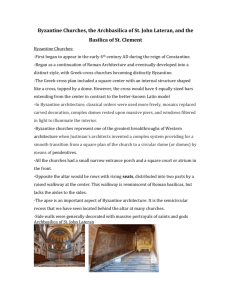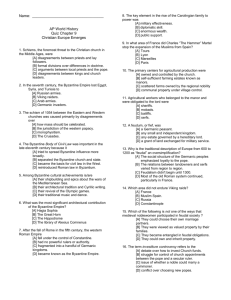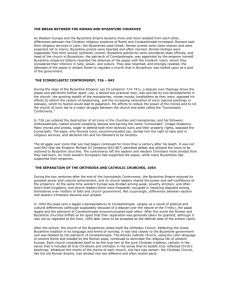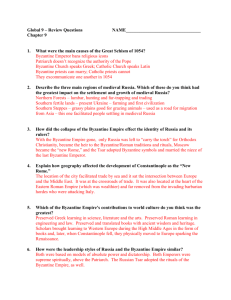early Christian and Byzantine art
advertisement
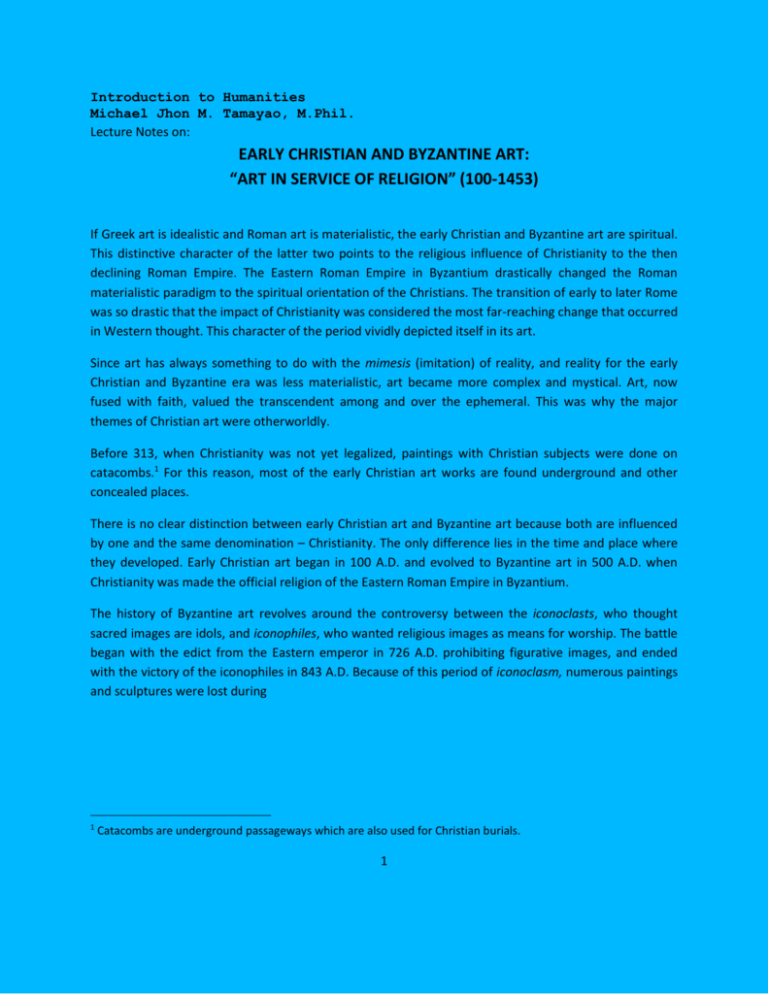
Introduction to Humanities Michael Jhon M. Tamayao, M.Phil. Lecture Notes on: EARLY CHRISTIAN AND BYZANTINE ART: “ART IN SERVICE OF RELIGION” (100-1453) If Greek art is idealistic and Roman art is materialistic, the early Christian and Byzantine art are spiritual. This distinctive character of the latter two points to the religious influence of Christianity to the then declining Roman Empire. The Eastern Roman Empire in Byzantium drastically changed the Roman materialistic paradigm to the spiritual orientation of the Christians. The transition of early to later Rome was so drastic that the impact of Christianity was considered the most far-reaching change that occurred in Western thought. This character of the period vividly depicted itself in its art. Since art has always something to do with the mimesis (imitation) of reality, and reality for the early Christian and Byzantine era was less materialistic, art became more complex and mystical. Art, now fused with faith, valued the transcendent among and over the ephemeral. This was why the major themes of Christian art were otherworldly. Before 313, when Christianity was not yet legalized, paintings with Christian subjects were done on catacombs.1 For this reason, most of the early Christian art works are found underground and other concealed places. There is no clear distinction between early Christian art and Byzantine art because both are influenced by one and the same denomination – Christianity. The only difference lies in the time and place where they developed. Early Christian art began in 100 A.D. and evolved to Byzantine art in 500 A.D. when Christianity was made the official religion of the Eastern Roman Empire in Byzantium. The history of Byzantine art revolves around the controversy between the iconoclasts, who thought sacred images are idols, and iconophiles, who wanted religious images as means for worship. The battle began with the edict from the Eastern emperor in 726 A.D. prohibiting figurative images, and ended with the victory of the iconophiles in 843 A.D. Because of this period of iconoclasm, numerous paintings and sculptures were lost during 1 Catacombs are underground passageways which are also used for Christian burials. 1 I. The Early Christian Period (100-500) Since it was in service of religion, art centered mainly on architecture (especially on building churches), sculpture, painting, and mosaics of religious images. A. Impetus for Churches The period was still under the influence of Roman art. Early Christian Architecture still used Roman techniques and forms. The early Christian churches for example have two basic types, which have their roots in ancient Roman architecture. These types were the Basilica (longitudinal) and the Central2 churches. Example of the Longitudinal (Basilica) Type of Church: Old Basilica of St. Peter Figure 1 Figure 2 Figure 3 2 This design is often used in Martyria (building marking the tomb or site of the death of martyrs). The Martyria are usually converted into churches. 2 Example of the Central Type of church: Figure 4. Santa Constanza But because of its radical reorientation, Early Christian Architecture changed its aim and modified its form accordingly. Whereas the Roman temples sought earthly grandeur, Early Christian Architecture withdrew from the materialistic world and stressed on giving a mystical experience for the faithful. The churches, for example, have a very simple exterior, which coincides with the denunciation of the transitory world. But their interior, however, are strikingly beautiful – adorned with mosaics, Greco-Roman colonnades, arcades, and priers – which aim at giving mystical experience to the people. Santa Constanza 3 Figure 6. Interior 1 Figure 5. Exterior Figure 7. Interior 2 B. Religious Paintings and Mosaics Early Christian Paintings and Sculptures were first done on catacombs in Rome before the fifth century. The catacomb paintings and mosaics depicted religious figures, from praying characters to miraculous stories of salvation in the Old and New Testaments. The painted figures were simple – sketchily painted, have large heads, glaring eyes, and ill-proportioned bodies. Usually these religious figures were placed within a geometrical design. Figure 8. Wall and Floor Mosaics in a Catacomb Before the development of the printing press, books, which were then illustrated, were multiplied manually. These “Illustrated Manuscripts” first appeared in “rotulus” form. Like the Roman scroll books, the rotuli have continuous texts, which are not separated 4 by pages but are only held by two rollers through which the reader unrolled the other side as he rolled up the other. But in the 1st and 4th centuries, the rotulus type was replaced by the “codex” form, the type which we now use today only that parchment3 was used instead of paper. The printed illustrations and (wall- and floor-) mosaics could be characterized simply as flat, fancifully colored, rigidly bold, partially abstract, and highly symbolic. These characteristics made them very effective expressions of early Christian theology. Figure 9. Illustrations in Manuscripts 1 Figure 10. Illustrations from Manuscripts 2 3 Parchment was the predecessor of the modern paper. It was commonly made from animal skin. 5 C. Religious Sculptures Ancient Romans were known to use sculptures to idolize their gods. Because of this, some of the early Catholics associated the veneration of sacred scriptures to idolatry. Thus, sculpture was confined to small-scale works, such as sarcophagi4, metal plates and chalices, containers for sacred reliquaries5, and ivory carvings. Like paintings and mosaics, sculptures were flat, ill-proportioned6, semi-abstract, and highly symbolic. The favorite subjects of the early Christian sculptures include the Miracle of Jonah and the Whale, the Raising of Lazarus, the Sacrifice of Isaac, Daniel in the Lion’s Den, the Healing of the Blind, and Moses Striking Water from the Rock. In comparison to the Greco-Roman sculptures, early Christian sculptures declined in beauty and significance. Nonetheless, after the victory of the iconophiles against the iconoclasts in 843 A.D., there was a significant upsurge, which is evidently seen today, in the production and development of religious sculptures. Figure 11. “Jesus giving missions to Sts. Peter and Paul.” Sarcophagus of Junius Bassus, c. 359. Marble, 3’10½ ” x 8’ Vatican Grottoes, Rome. II. The Byzantine Period (500-1453) After the legitimization of Christianity in Rome, the Byzantine period took place. It was the emancipation of the then hidden but budding Christian culture. Early Christian art evolved into the Byzantine art. 4 Sarcophagi are tombs or caskets of both religious and royal dignitaries. 5 Repositories for any sacred object or person. 6 The heads are too big for the body. Natural anatomy is disregarded so that the figures are doll-like. 6 A. Byzantine Architecture The two types of Churches in the early Christian era merged during the Byzantine period. The Basilica (longitudinal) was fused with “Domed” Central Churches. By merging the two styles, the Domes became a central feature of Byzantine architectural design. Just as they symbolized the heavens by covering the sacred places during the early Roman period, domes in the Byzantine period were also used as a basic design for churches. They were constructed using porous stones and hollow buttressing. Aside from the physical reduction of weight, Byzantine architecture also concealed structural masses with flat mosaic decorations and multi-colored marble veneer. The walls looked thin and supporting structures looked delicate because of their design. The apparent weightlessness and delicateness of the interiors evoke the supernatural qualities of sacred places. Figure 12. Atik Mustafa Pasa Camii – Byzantine church converted into a mosque Figure 14. Church in West-Crete Figure 13. San Vitale 7 Figure 15. “Christus Pantocrator” inside the dome of the Chora Church. B. Paintings and Mosaics Because the capital of the Roman Empire was transferred to Byzantium, which was a heavily eastern colony, western art fused with the eastern. This is evidently seen in the Byzantine paintings and mosaics. In manuscript illuminations, for example, the Roman style was influenced in varying degrees by the Eastern style. The stylistic heritage of eastern painting of the “bearded” Christ, in particular, changed the early Latin painting of the “beardless” Christ. Christ and Mary from the Deesis Panel of the South gallery of Hagia Sophia 8 Figure 17. Mary Figure 16. Christ Nonetheless, paintings and mosaics produced in and around Constantinople were still heavily eastern in style, i.e. very symbolic and semi-abstract typifying Egyptian and Syrian art. Since the period revolved around the battle of the iconoclasts and the iconophiles, Byzantine art’s decline and golden age coincide with the development of the event. Paintings and mosaics were minimized during the iconoclastic period. This era signaled the dark age of the Byzantine art. And because the production of paintings and mosaics, especially of religious figures, were encouraged after this period (of iconoclasm), the following era became Byzantine art’s golden age. Post-iconoclastic artworks expressed more emotion, more massiveness, and depicted the natural anatomy of man more realistically than the Christian period. 9 Figure 18. Empress Theodora (547 A.D.) Figure 20. Byzantine Painting of Mary Figure 19. Byzantine Painting of Christ and Child Jesus C. Sculpture There was little monumental sculpture in the Byzantine period. The sculptures, because again of iconoclasm, were only small-scale relief sculptures on religious objects like the reliquaries. Sculptural designs were also found on chalices and 10 other religious icons.7 The portability of these diminutive works nevertheless helped spread the influence of Byzantine art. Figure 23. Byzantine Cross with border curvings Figure 21. DIptych of Anatasius, 517. Figure 24. Byzantine Chalice Figure 22. Ivory diptych of Christ and the Mother of God, Constantinople, 4th century Figure 25. Byzantine Cross 7 The question of whether the ornamental designs on religious items, like chalices and crosses, are sculptures or merely “designs” is another subject of discussion. The author nonetheless presupposes the first option as the answer to the issue. 11 III. Simple Art Notes Early Christian and Byzantine periods place art in service of religion. Because religion is spiritual, art is mystical, almost abstract. Thus, it disregards natural scale relationships between figures, it prefers flat ornate surfaces than mass and depth, and it has stiff figures with mask-like faces. But after the iconoclasm, there’s a sudden proliferation and revival of Greco-Roman art. This period of “rebirth” is known as the Renaissance. 12
